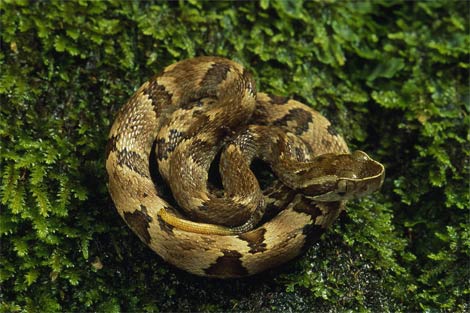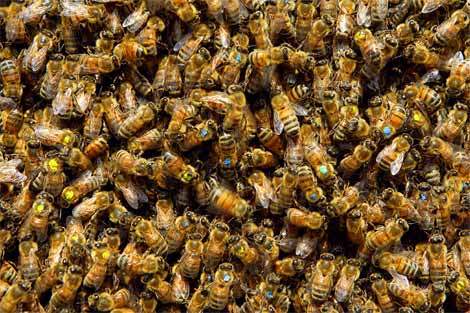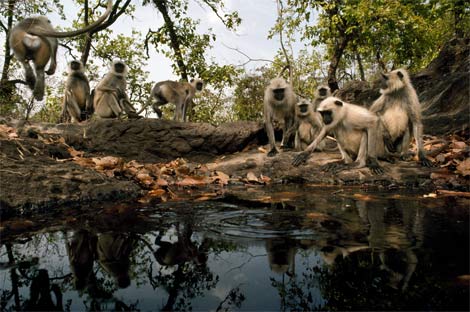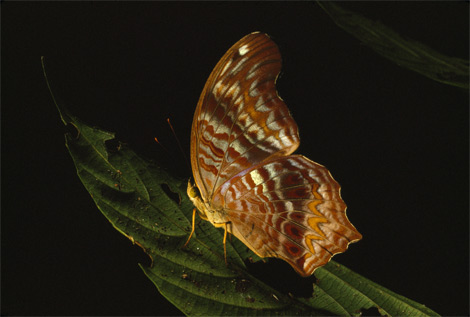
在巴西的雨林中,一條年輕的埡拉拉卡蝰蛇正盤踞在長滿苔蘚的地上。這種劇毒的蝰蛇是矛頭蛇的一種,在其分布地區(qū)十分常見,并在巴西,巴拉圭和阿根廷等地造成了大量的毒蛇咬傷事故。
Photograph by George Grall
A young jararaca snake lies coiled on a mossy piece of ground in the Brazilian rain forest. These venomous pit vipers, members of the lancehead, or fer-de-lance, family, are common throughout their range and are responsible for a large number of snakebites in Brazil, Paraguay, and Argentina.
蜜蜂,(美國州名)緬因 Honeybees, Maine

由蜜蜂組成的群體,如圖中緬因州阿普爾多爾島上的這群,經(jīng)常會對建巢的地點產(chǎn)生分歧。但它們一般都能選出最佳位置。蜜蜂們通過收集信息,開展獨立評估以及進(jìn)行某種表決來得出最后的決定。科學(xué)家們正在研究這種群體智能–如圖中帶有黃色和藍(lán)色標(biāo)識的蜜蜂,尋找某些相關(guān)線索,并以此推斷人類應(yīng)如何對復(fù)雜的系統(tǒng)進(jìn)行操作,無論是運(yùn)輸路線還是軍事機(jī)器人。
Photograph by Peter Essick
Swarming honeybees, like these on Maine’s Appledore Island, frequently differ about where to establish a new nest. But the group usually chooses the best site. Bees reach this decision by gathering information, conducting independent evaluations, and holding a kind of vote. Scientists are studying such swarm intelligence-note the yellow and blue identifier dots on the bees in this photo-for clues about how humans might manage complex systems, from truck routing to military robots.
哈奴曼葉猴 Monkeys at Watering Hole, India

在印度的斑德哈瓦加國家公園,一群哈奴曼葉猴趁著老虎不在,到水潭旁飲水。這些體瘦尾長的猴子的名字源于印度教中的猴神哈奴曼,分布在潮濕的森林和沼澤中,甚至在印度,巴基斯坦,孟加拉,斯里蘭卡和緬甸等國的城市地區(qū)也能發(fā)現(xiàn)。
watering hole 海濱勝地, 水池, 池塘
Photograph by Michael Nichols
A troop of Hanuman langur monkeys drinks from a watering hole used by tigers in India’s Bandhavgarh National Park. Named after the Hindu monkey god Hanuman, these lanky, long-tailed monkeys are found in the humid forests, swamps, and even urban areas of India, Pakistan, Bangladesh, Sri Lanka, and Myanmar (Burma).
落在葉子上的蝴蝶 Butterfly on Leaf, Borneo, Malaysia

在婆羅洲的沙巴的丹濃谷保護(hù)區(qū)中,一只蝴蝶正在夜幕的掩護(hù)下優(yōu)雅的在一片葉子上合翅休息。這片170平方英里(438平方公里)的保護(hù)區(qū)是馬來西亞最大的原始低地雨林,有著世界上最復(fù)雜的生態(tài)體系之一。
Photograph by Timothy Laman
Under the cover of darkness, a butterfly with folded wings rests gracefully on a leaf in the Danum Valley Conservation Area in Sabah, Borneo. The 170-square-mile (438-square-kilometer) conservation area is the largest undisturbed lowland rain forest in Malaysia, home to one of the world’s most complex ecosystems.











